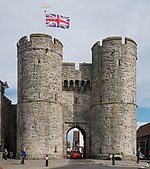The Archbishop's School
The Archbishop's School is a mixed-ability Church of England secondary school and sixth form located on a parkland site on the outskirts of Canterbury, Kent, England. It is a school for pupils and students of all abilities from the ages of 11 to 19, and has approximately 850 pupils. The school was founded in 1958.The Archbishop's School is situated on St Stephens's Hill, in the village of Hackington (not to be confused with the civil parish of the same name), approximately a mile North-West of the city centre. The Rector of Hackington (St Stephen's) is an ex officio Governor of the school, and since 2014 has also held the office of school chaplain (prior to 2014 this was a separate appointment).It has six houses named Matthew, Mark, Luke, and John, after the four Evangelists, and two others, Paul and Peter, named after the apostles of those names.
Excerpt from the Wikipedia article The Archbishop's School (License: CC BY-SA 3.0, Authors).The Archbishop's School
St. Stephen's Hill, Canterbury Hales Place
Geographical coordinates (GPS) Address Nearby Places Show on map
Geographical coordinates (GPS)
| Latitude | Longitude |
|---|---|
| N 51.293055555556 ° | E 1.0741666666667 ° |
Address
St. Stephen's Hill
CT2 7AU Canterbury, Hales Place
England, United Kingdom
Open on Google Maps






